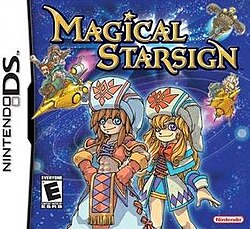Magical Starsign (series)
| Magical Starsign | |
|---|---|

Front cover of the U.S. Magical Starsign package.
|
|
| Developer(s) | Brownie Brown |
| Publisher(s) | Nintendo |
| Director(s) | Nobuyuki Inoue |
| Artist(s) | Shinichi Kameoka |
| Composer(s) | Tsukasa Masuko |
| Series | Magical Starsign |
| Platform(s) | Nintendo DS |
| Release | |
| Genre(s) | Role-playing video game |
| Mode(s) | Single Player, Multiplayer (up to 6 players on Local Wireless) |
Magical Starsign, originally released in Japan as Magical Vacation: Itsutsu no Hoshi ga Narabu Toki (マジカルバケーション 5つの星がならぶとき), is a role-playing video game for the Nintendo DS developed by Brownie Brown. It is the sequel to the Japan-exclusive Game Boy Advance title, Magical Vacation. Magical Starsign is the second game in the Magical Starsign series and was released in Japan and the United States in 2006 and was released in Europe the next year. Nintendo Australia has said that it would not publish the game in the Oceanic region as it expected low sales of the game.
The player uses the Nintendo DS's touch screen for character control and interaction, while the top screen displays maps and other general information. The battle system is turn-based, and the position of the planets within the game affects the amount of damage wielded or received by each character. All characters in the game are associated with a specific planet, and their magic attack power is boosted when a character's planet is positioned favorably. Players can also boost their attack power by tapping their character when the circle of symbols has disappeared around them during a battle. This is known as a "Spell Strike", and a large flash of color (the same color assigned to the character's element) appears prior to the attack. The player may also tap their character right before they are hit with an attack to receive less damage. This is known as a "Reflex Guard," and puts the character into a guard stance and causes them to glow with blue light. However, some attacks cannot be guarded against in this way.
There are 7 different elements in the game (light, darkness, fire, water, wood, earth, and wind) which each correspond to a planet in the game's solar system. The Astrolog tracks the movement of these planets, which move clockwise around a central point as time passes within the game. The orbital velocity of each planet varies according to their size and location. Magic spells of certain elements are twice as effective while a planet is orbiting within the area assigned to its corresponding element. This bonus applies for both the player's magic spells and enemy spells. The light and dark elements are instead affected by solar activity: light magic is more powerful during the daytime, and dark magic is more powerful during the night (in-game time is viewable as an animated hourglass). A certain spell acquired later in the game allows the player to move the planets to an advantageous position; or potentially align the 5 planets in a straight line (as indicated in the Japanese version's subtitle), which causes far more damage than the standard elemental bonus. The planets may also happen to align without using the spell, but this causes damage to both the player and the enemy.
...
Wikipedia
